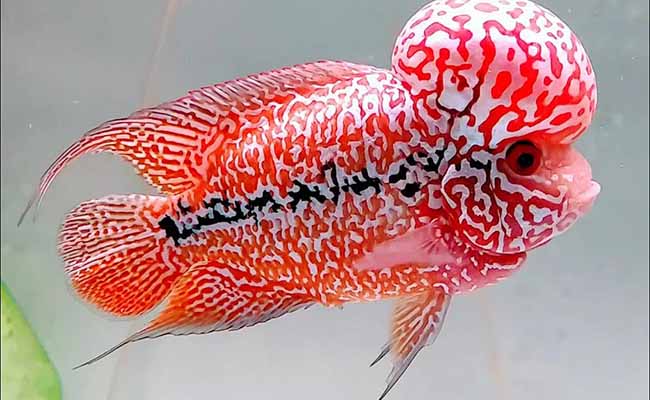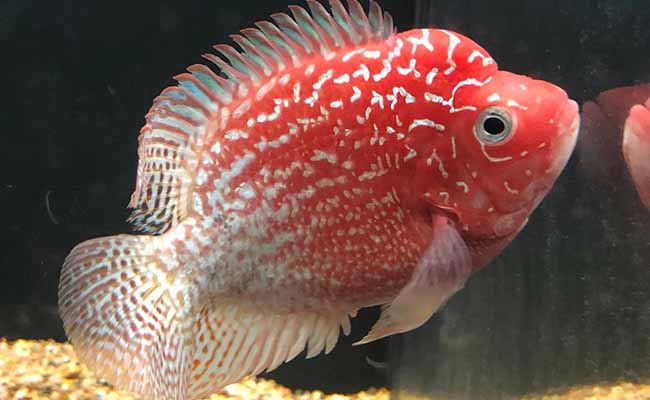Amphilophus hybrid or Flowerhorn fish are hybrid species. The first Flowerhorn was born in 1994. Now, numerous types are available. They are unique, with different strains and abilities. They have a flower-like head and colorful appearance. Read the following to learn more about this beauty and especially about how a flowerhorn reproduces.
Content Table
In the following, you’ll learn about a brief introduction to major Flowerhorn types with some other beautiful types. Breeding difficulty of different types and how to breed Flowerhorns in a home aquarium are also part of this article. How to breed flowerhorns? Follow the flowerhorns breeding steps for having a beautiful next generation.

How to breed flowerhorns
Flowerhorn Types
Birth of Beauty
Flowerhorn fish are a hybrid species that was born in 1994. Two Central American, i.e., Trimac cichlids and red devil cichlids, and one Taiwan fish, i.e., hybrid blood parrot cichlid, were used to breed this species. With their cross, the scientists have a new species, i.e., Flowerhorn cichlid. There are 4 main types of Flowerhorn fish.
Kamfa
| Kamfa is among the famous Flowerhorn types, known for its multicolored bodies, i.e., blue, red, yellow, and orange. They have a large nuchal hump and long flowing fins with yellow or white eyes.
They are curious creatures and always love to explore their surroundings. Moreover, they are highly energetic, which makes them aggressive toward others. They can grow up to 4 to 5 inches in length. |
 |
Kamalau
| Golden Monkey and KML are the other names of Kamalau Flowerhorn cichlid. As the name suggests, they have monkey-like faces with yellowish or golden bodies. Orange or red coloration makes them eye-catching. The Malaysian Mr. Lam Seah and Lam Soon bread it during the first decade of the 21st century.
They are territorial and require a large tank, i.e., 75-gallon, with open swimming space and numerous hiding spots. They can grow up to 55 cm inches in length. These omnivores are easy to care for and can live up to 10 years. |
 |
Chinese Zhen Zhu
| Shortly named, Zhen Zhu is another Flowerhead type, which has pearl-like smooth skin. They are white or yellow with some orange or red shade. Like other flowerhorn cichlids, they also have a large nuchal hump with long fins. They can grow up to 30 cm. |  |
Golden Base
| It’s a group that includes faders and the golden trimac Flowerhorn cichlid species. They have a unique wide fantail and stunning coloration. They are massive and have a golden base. They can grow up to 3 to 5 inches. To handle their aggression, large size, and territorial behavior require at least a 55-gallon tank. |  |
Other Bred Types
It has many other bred types that include the following:
| Devil Wolf Flowerhorn | Red Dragon Flowerhorn | King Kong Parrots |
| Rose Queen Flowerhorn | Red Texas | Red Ingots |
| Super Red Monkey (SRM) | Thai Silk | Blue Dragon Flowerhorn |
Can Flowerhorns Reproduce
Yes, Flowerhorn cichlids can reproduce in home aquariums. The ease of breeding varies among different species. Chinese Zhen Zhu species are the easiest species to breed in the home aquariums.
Meanwhile, Kamfas are hard to reproduce due to low fertility and compatibility. However, their chance of success increases when crossed with Zhen Zhu because they are a higher fertility rate species.
Golden Monkey shows a similar behavior to Kamfa Flowerhorn cichlids. Golden bases or faders show a medium breeding difficulty. The following table shows the ease of breeding for some other famous Flowerhorn types.
| Flowerhorn Type | Breeding Difficulty |
| Thai Silk Flowerhorn | Hard |
| King Kamfa | Hard |
| Super Red Dragon | Medium |
| Red Texas | Hard |
| Kamfa Malau | Between medium and hard |
How Does Flowerhorn Fish Reproduce?
The Male Flowerhorn begins to chase the female and tries to intimidate it. Once the females show readiness, they mate with each other. After successful mating, the female lays eggs on clean, flat surfaces, and the male fertilizes these eggs. After fertilization, the female guards these eggs, even from the male. After 3 to 5 days, eggs hatch and go through different growth stages.

Can flowerhorns reproduce
What Are the Behavioral Traits of the Pregnant Flowerhorn Fish?
Here are some behavioral traits that a pregnant Flowerhorn fish has.
- They have swollen abdomen, indicating that they are carrying eggs.
- Ovipositor, i.e., egg-laying tube, becomes more visible.
- They show aggressive behavior towards other companions.
- They begin to guard a specific portion of the tank, i.e., a possible egg-laying spot in the tank.
- A pregnant flowerhorn begins to clean a flat surface with its male partner.
How to Breed Flowerhorns?
Preparation of Breeding Tank
Prepare a bare-bottom separate breeding tank for a successful reproduction. The suitable water parameters for the breeding tanks are as follows.
| Parameter | Value |
| pH | 6.0–8.0 |
| Temperature | 27–30°C (80–85°F) |
| Water Hardness | 6–20°dGH |
| Tank size | 75–gallon |
| Flat clay plate | 1 |
Parent Selection
Flowerhorn parent selection is among the most pivotal aspects to achieving specified results, i.e., specific color and traits. Here are some considerations for a successful same-breed or different-breed reproduction.
- Select an 8-month-old male Flowerhorn and a 6-month-old female to make a perfect pair.
- Male size should be 40% greater than female to avoid fin, Kok, and other body damage.
- Select a dewormed female for a better fertility rate.
Pre-spawning
Separate both with a transparent glass divider and feed them on high-protein food, i.e., blood worms. Remove the plate and allow them to mix freely when aggression is reduced.
Courtship
The male follows the female and tries to attract the female partner. Once the female partner shows readiness, they mate. After successful mating, they mate mouth-to-mouth.
Laying Eggs
The female partner lays eggs on a clean and flat surface in a line, and the male follows to fertilize these eggs. It does the procedure until the female partner lays their eggs. Typically, a female lays about hundreds of eggs at a time.
Care and Hatching
After fertilization, the female guards the eggs and keeps everyone away from the eggs. Properly oxygenate these eggs. If environmental conditions are suitable, eggs hatch within 3 to 5 days. After hatching, remove both parents from the tank. It’ll take about more 3 to 5 days to become the fry as free swimmers.
Fry Care
After hatching, feed them commercially available fry food. After a few weeks, feed them on small brine shrimps and powdered flake. Create a low-pressure environment to avoid accidental suction in the filter. Maintain the water quality by changing 10 to 20% fry tank water after 4 to 5 days.

Flowerhorn types
Key Takeaways
- Flowerhorn was bred in 1994 in Malaysia.
- There are several flower horn types. 4 are main, i.e., KamFa, Kamalau, Golden base, and Zhen Zhu.
- Flowerhorn can reproduce in home aquariums, but reproduction varies among different species.
- Female Flowerhorn cichlid indicates specific attributes of pregnancy, i.e., swollen abdomen, increased appetite, aggressive behavior, etc.
- Set up the tank, select proper partners, and separate them with a glass divider.
- When the aggression lowers, remove the divider and allow them to mate.
- The female lays the eggs, and the male fertilizes them.
- After 3 to 5 days, eggs hatch, and after 14 days, they become free swimmers.


Leave a comment